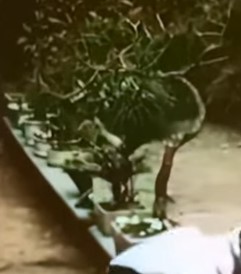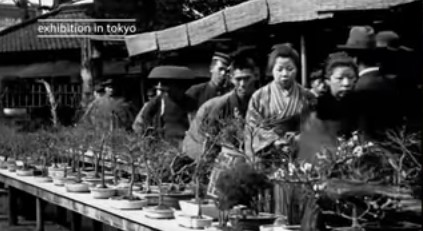In February 1910, the first newsreel from CGPC, the newly-established
UK arm of Compagnie Générale des Établissements Pathé Frères Phonographes
& Cinématographes was released in cinemas. The following year, the company today known as
British Pathé made, among several others, a
brief film titled Tiny timber, The Art of the Dwarf Tree from Old Japan. This 1:18 silent short
now-known from a badly decomposed original nitrate
film includes the earliest depictions of wiring a deciduous tree and pinching conifer needles, before ending
with a shot of a non-containerized miniature landscape -- known five decades later as saikei. A print
was made by the National Film and
Television Archive (NFTVA), probably in the 1990s. That film was then digitized in 2002.
With much close examination and many viewings by RJB,
the film is as follows :
00:01, an intertitle/title card: "Tiny / timber" (in two rows) "The Art of / the Dwarf / tree
from / Old Japan" (in four rows) on the right-hand side; cursive Roman writing of "Pathé / Pictures
/ 621" (in three rows) in the lower left corner. The orange subtitle "Copyright
British Pathe -- for preview only" (in one row) partly covers the lower left writing throughout the
entire film; a slant-style large-leaved deciduous tree in a small and dark deep round pot on a lighted
stand/lamp, the tree trunk which is placed diagonal from upper left towards the middle of the image and the
pot are spotlighted in the upper left half.
00:09, an intertitle: "These are really / grown-up trees / which were planted / in their youth --" (in
four rows) centered, with printed "PATHÉ PICTORIAL" [sic] in the lower
left (seen only on the intertitles and in one row); again, the lower left words were partly obscured by
the orange text of the subtitle
00:14, a view that is very darkened, especially in the upper right half of the scene, of several groups
of potted trees in an assortment of round pots and possibly four stones, the edge of a rectangular pot is seen
at the lower left edge; close-together, the pots and stones appear to be on a slightly raised wooden plank
platform
00:20, a view that is only slightly lighter than the previous shows a man in a light-colored
short-sleeved shirt and a boater hat is squatting just left of center working on a tree in a low round pot; a
second person in the center partly hidden by the tree and possibly wearing a darker happi coat is facing the
camera just beyond the squatting man and seems to be wiring a second tree; a third person is working just at
the right edge of the picture; to the left is a large pot; several posts towards the rear are seen
extending up out of the top of the picture, and the tops of some walls and a roof towards the upper center and
right indicate that this is all taking place in a courtyard garden area, plants in the background hiding the
lower portions of the wall
00:28, a closer view of the man working on the tree, possibly wiring the trunk, the end of this sequence
showing some distortion/bubbling
00:35, an intertitle, which is mostly illegible from the now distorted/bubbled film image: "Stunting
is a systematic / and patient procedure -- / and a fine art, too -- (in three rows)
00:42, looking over the man's right shoulder while he is wiring a thin branch on a deciduous tree, his
left hand stabilizing the branch while his right hand wires, and at the last moment
00:56, white screen
00:57, the lower half of a man in short-legged pants and high white socks on the left side reaching to
a potted tree (pine?) in the center in a tall narrow light-colored rectangular pot, while another person similarly
attired but wearing a coat also is on the right side -- this must have been a longer shot originally
00:58, a close-up of a conifer being needle-pinched by the man's somewhat dark-skinned hands, which are
in the upper-right half of the screen
01:07, a few wide light-colored plank shelves holding several potted trees extend away from the camera;
the two planks on the left have trees in round pots, while the two on the right have trees in rectangular
containers; a few light-colored wooden posts are seen towards the rear as well as a light-colored Japanese
lantern in the upper right corner; the camera pans very slightly to the left and there is some movement of the
tree branches from the wind can be seen
01:13, a two-layered thick rough-textured rock with small pine seedlings is seen, the lower layer being
roughly rectangular in shape and the upper layer being crescent-like on top of the left and center rear half; 6-8
seedlings are on the top of the crescent, while 2-3 more are on its left front; the rock appears to be positioned
on a light-colored wooden plank, with another plank without any items behind it, and then a darker (shadowed?)
vertical plank serves as a background
01:18 the film ends with the rock's image.
1 |

